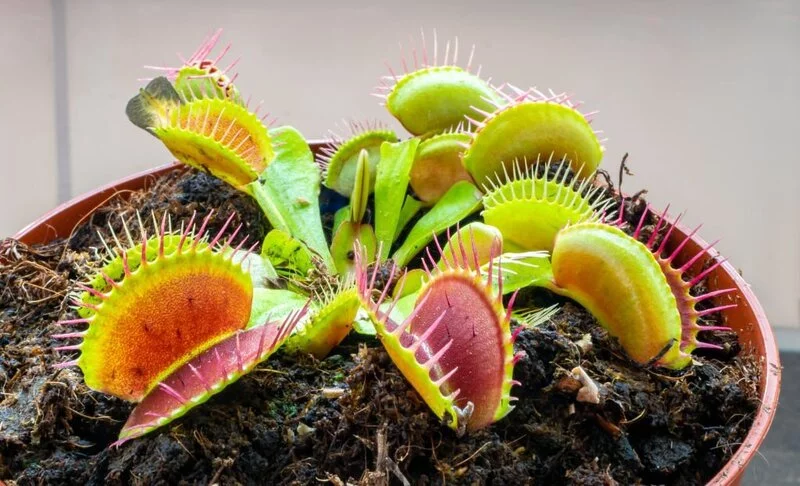Imagine a plant with a touch of the otherworldly, a living mystery that’s part botanical wonder and part fascinating carnivore – that’s the Venus Flytrap for you! These small but mighty plants are fascinating additions to any home or garden, catching unsuspecting insects with their jaw-like leaves. But just like any pet, they need some extra care and attention to thrive. One crucial aspect of caring for a Venus Flytrap is knowing when and how to repot it. If you’re up for the task, buckle up as we guide you through the process. Don’t worry – it’s simpler than you think!
- 🍏 IDEAL ACIDITY — Your Carnivorous Plants will be Living in this Stuff For Their Whole Life; Organic Blend, Consistent Long Term Enriched Growing Medium
- 💧 WATER MANAGEMENT— Fantastic Water Control for Carnivorous Plant and Holds the Required Moisture in the Soil; Perfect for Carnivorous Plants of All Types Including: Venus Flytraps, Pitcher Plants, Sundews, and Bladderworts
- 🇺🇲 PROFESSIONALLY MIXED IN THE USA — From the Growers at Perfect Plants, Amazing When Used with All Carnivorous Plant Types
- ✅ 4 QUARTS — Perfect for 3-4 Carnivorous Plant Containers
- ⚙ HEAVY DUTY, RE-SEALABLE BAG — Keeps the Soil Fresh, Easy Storage for Later Use
Understanding When to Repot Your Venus Flytrap
Now, you might be wondering, “How do I know when it’s time to change my Venus Flytrap’s home?” Well, these fantastic plants are quite good at sending signals when they need a change. Here are some tell-tale signs that your green pet might need a new pot.
- Overcrowding: Venus Flytraps multiply by growing baby plants, or “pups”, near their base. When you see your pot becoming a little crowded, with several plants jostling for space, that’s a cue to consider repotting.
- Stunted growth or yellowing leaves: Are your Venus Flytraps’ leaves staying puny or turning a sickly yellow? It could be a sign that they’re running out of nutrients in their current soil and need a fresh start.
- Time: Venus Flytraps generally appreciate a new pot and fresh soil every year or two. Even if you don’t see the above signs, regular repotting can help keep your carnivorous companion happy and healthy.
As for the best time to undertake this task, Venus Flytraps go dormant in winter, just like some other plants. That’s the perfect time to repot, as the plant is less likely to be stressed by the move. So, mark your calendars for late winter or early spring, and prepare to give your plant a brand new home!
Gathering the Necessary Materials
Before we embark on our repotting adventure, let’s get our toolkit ready. Here are the essentials you’ll need:
- New Pot: Start with a clean pot, preferably a plastic one. Why plastic? It’s lighter, retains moisture better, and won’t add any unwanted minerals to the soil.
- Potting Mix: Venus Flytraps love a soil mixture of sphagnum peat moss and sand or perlite. They like their soil slightly acidic and well-draining, and this mix hits the spot!
- Distilled Water: Unlike other plants, Venus Flytraps aren’t fans of tap water. They prefer rainwater or distilled water. If you can’t get either, then use filtered water.
- A Little Patience and Care: Okay, this one isn’t exactly a ‘material,’ but you’ll need a gentle touch and some patience while handling your Venus Flytrap, especially when freeing it from its old pot.
Don’t worry if you don’t have everything at hand right away. You can find these materials at your local garden center or online. And remember, it’s all about creating a comfy, new home for your green friend.
Preparing for Repotting
Now that we have our materials ready, let’s roll up our sleeves and get to work. Here’s how to prepare for the big move:
- New Home Prep: Fill your new pot halfway with the damp soil mixture. This is going to be the base for your Venus Flytrap.
- Unpotting Your Plant: Time to get your hands dirty. Gently remove the Venus Flytrap from its old home. Be careful while loosening the soil around the edges of the pot. We want to free the roots without damaging them.
- Root Care: Once you have the plant out, take a moment to examine the roots. If you see any that are brown or mushy, trim them off. Healthy roots are white and firm.
Remember, your Venus Flytrap might look a bit startled at first. But it’s all for a good cause. This move is the first step towards a happier, healthier plant life!
- REAL VENUS FLY TRAP PLANT: Large carnivorous plants that feed on bugs with jaw-like petals aka ‘bug traps’. This dionaea plant is a useful flying and non-flying insect trap, able to grow in a carnivore plant pot, carnivore plant terrarium, and more.
- FLY AND MOSQUITO TRAP: Functional house plants that trap and consume common bugs found in the home, such as flies, mosquitos, and spiders. Keep your carnivorous house plant thriving by planting it in a carnivorous plant pot with venus fly trap soil.
- DIY INDOOR TERRARIUM: Design a unique carnivorous plant terrarium with live flytraps and other terrarium plants. Real plants are also excellent for gift ideas. Create a Venus Fly Trap kit with Venus Flytrap soil, carnivorous plant food, and more.
- STRIKING PLANT DÉCOR: Showcase this stunning plant in a Venus Fly Trap pot with a carnivorous plant soil mix for an eye-catching display. Try planting your own Dionaea muscipula seeds in flytrap soil with Dionaea muscipula food to support growth.
- LIVE CARNIVOROUS PLANTS AT YOUR DOOR: Venus Fly Trap live plants (Dionaea Akai Ryu) will arrive fresh and in prime condition. These exotic plants can thrive as both live indoor plants or outdoor plants.
The Repotting Process
Alright! It’s showtime. We’ve come to the most exciting part of our journey – the actual repotting. Here’s the game plan:
- Planting: Position your Venus Flytrap in the center of the new pot, gently spreading out the roots over the base soil layer.
- Cover Up: Now, cover the roots with more of your soil mix until the plant stands firm. But don’t bury it too deep. Make sure the leaves are above the soil, with only the roots and a bit of the stem covered.
- Watering: Once your plant is snug in its new home, give it a welcome drink with some distilled or rainwater.
And voila! You’ve successfully repotted your Venus Flytrap. Great job!
Aftercare
Just like moving to a new house can be a bit jarring for us, your Venus Flytrap might take some time to adjust. So, here’s what you need to do:
- Keep it Hydrated: Ensure the soil stays moist but not waterlogged. Remember, distilled or rainwater only!
- Location, Location: Venus Flytraps love lots of light. Find a sunny spot where your plant can bask for at least 4-6 hours each day.
- Feeding: No need to feed it immediately after repotting. Give it a few weeks to settle down first.
- Watchful Eye: Keep an eye out for any signs of stress, like wilting or discoloration. But don’t fret. With proper care, your Venus Flytrap will be back to its bug-catching best in no time!
- Solid Cube Gel: Unlike other liquid plant food, our Venus flytrap food is designed to mimic actual prey, providing a more natural and effective stimulation to the plant’s system. This solid gel closely resembles real prey, ensuring that your Venus flytrap receives the nutrients it needs in a way that encourages optimal growth and health.
- Dinner Time: Whether your carnivorous plants are not in a mood to hunt, or you lack the necessary food for it, you can always count on this solid gel food.
- Easy to Digest: Besides the necessary vitamins, and essential nutrients, this all-purpose plant food is mess-free and is the optimal solution for your Venus Fly Trap plant digestion.
- Versatile Food Item: Regardless of your plant, we got most carnivore plant covered. From Venus Flytrap and Sundew to Pitcher Plants, we developed this small Venus fly trap food suitable for every type.
- Instructions: Feed your plant with one cube weekly. If the plant is small, please cut the cube into smaller size. Apply the gel cube on plant’s feeding area
Conclusion
And there you have it! A complete, beginner-friendly guide to repotting your Venus Flytrap. Don’t worry if you stumble a bit at first. Remember, practice makes perfect, and your plant will appreciate your efforts. So go ahead, roll up your sleeves and give your carnivorous friend the wonderful, roomy new home it deserves. After all, there’s something incredibly satisfying about nurturing a Venus Flytrap, wouldn’t you agree?






